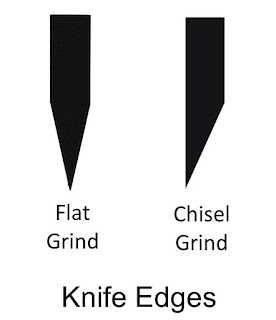
Japanese
carving knives for woodblock printing typically feature chisel ground blades. This particular grind is
sharpened with a single bevel on one side of the blade, while the other side is
completely flat. (Although only one side of the blade is ground at an angle, the flat
side of the blade must be honed to remove the burr that develops in the
sharpening process.)
The
angle, at which the beveled side of a chisel ground blade is generally
sharpened, is between 25° and 35°. This angle creates a very sharp yet durable
edge. In carving a woodblock this type of knife produces a very clean edge in
the wood. Chisel bevel knives are available with either a right or left hand blade (see the photo below).
 |
Chisel ground knives are angled
on one side of the blade with the other side being flat. Flat ground knives have a "V" shaped profile with both sides of the blade at the same angle. |
Compared
to a chip carving knife, which features a flat grind, in which both sides of
the blade are sharpened at a very shallow 10° angle, the Japanese carving
knives have more metal at the edge. This makes the chisel grind better suited
when cutting hard woods. In carving panels for relief carving, cherry wood, which is
a hard wood capable of holding good detail, was traditionally used in Japanese
relief printing. Chip carving knives, on the other hand, are designed for
softer woods, such as basswood or butternut.
NOTE:
There are many different types of flat ground blades, sharpened at different
angles. High Flat and Saber style blades, both of which are ground at relative
shallow angles, are often used for carving and woodworking. While these knives
may be very sharp, they typically dull quickly, because there is not much steel
near the edge of the blade. Whether you are carving with a knife with a chisel
ground blade or a flat ground blade, you should get in the practice of
sharpening your knife prior to every carving session.
Several other types of Japanese tools are available. An excellent source of tools and materials for relief carving is:
McClain's Printmaking Supplies
15685 SW 116th Avenue PMB 202
King City, OR 97224-2695
www.imcclains.com
800.832.4264
International: 00.1.503.641.3555
RELATED ARTICLES
What is Relief Printing?
What are Ukiyo-e Prints?
How Japanese Printmaking Influenced Western Art
The Evolution of Color in Japanese Woodblock Printing
What are Ukiyo-e Prints?
How Japanese Printmaking Influenced Western Art
The Evolution of Color in Japanese Woodblock Printing
Checklist for Relief Printing with Oil Based Ink
Japanese Carving Tools for Woodblock Relief Printing
Japanese Carving Knives for Woodblock Printing
Safely Carving Woodblocks, Woodcuts and Linocuts
Linocut Tips
Japanese Papers for Printmaking
How Japanese Mulberry Paper is Made
How Handmade Papers in the West are Made
Selecting a Brayer for Relief Printing
Selecting Wood for Relief Printing
Selecting an Ink for Relief Printing
Inking the Woodblock Panel
Clean Up After Relief Printing
Japanese Carving Tools for Woodblock Relief Printing
Japanese Carving Knives for Woodblock Printing
Safely Carving Woodblocks, Woodcuts and Linocuts
Linocut Tips
Japanese Papers for Printmaking
How Japanese Mulberry Paper is Made
How Handmade Papers in the West are Made
Selecting a Brayer for Relief Printing
Selecting Wood for Relief Printing
Selecting an Ink for Relief Printing
Inking the Woodblock Panel
Clean Up After Relief Printing
About Jim Hingst: After fourteen years as Business Development Manager at RTape, Jim Hingst retired. He was involved in many facets of the company’s business, including marketing, sales, product development and technical service.
Hingst began his career 42 years ago in the graphic arts field creating and producing advertising and promotional materials for a large test equipment manufacturer. Working for offset printers, large format screen printers, vinyl film manufacturers, and application tape companies, his experience included estimating, production planning, purchasing and production art, as well as sales and marketing. In his capacity as a salesman, Hingst was recognized with numerous sales achievement awards.
Drawing on his experience in production and as graphics installation subcontractor, Hingst provided the industry with practical advice, publishing more than 150 articles for publications, such as Signs Canada, SignCraft, Signs of the Times, Screen Printing, Sign and Digital Graphics and Sign Builder Illustrated. He also posted more than 450 stories on his blog (hingstssignpost.blogspot.com). In 2007 Hingst’s book, Vinyl Sign Techniques, was published. Vinyl Sign Techniques is available at sign supply distributors and at Amazon.




Interesting and impressive information, definitely will be helpful for those who are looking for japanese knives types and related services.
ReplyDelete